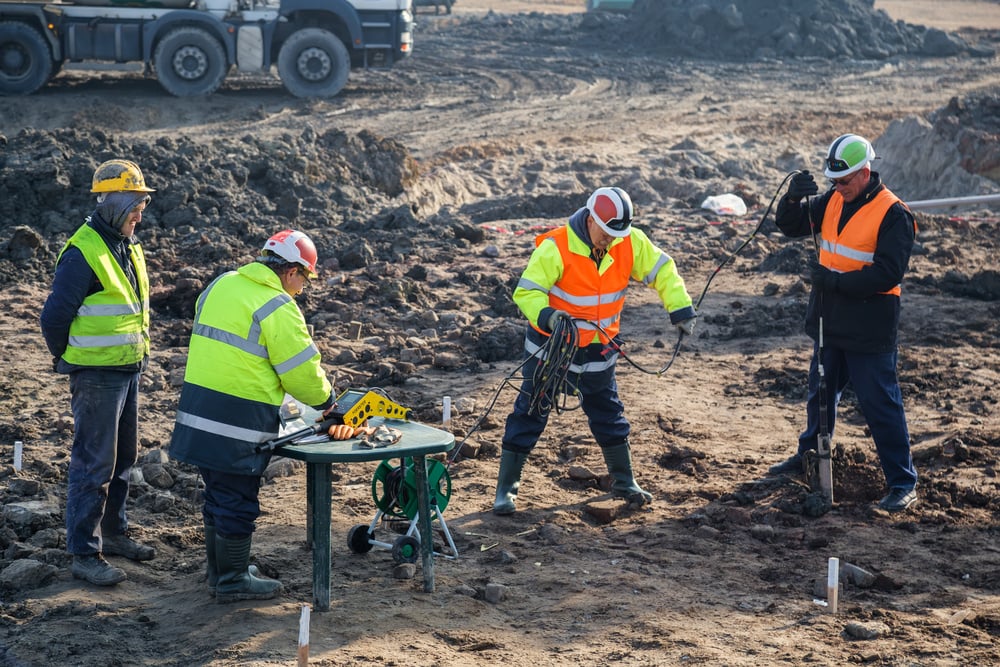The Ultimate Guide To Geotechnical Engineering For Construction Projects
The Ultimate Guide To Geotechnical Engineering For Construction Projects
Blog Article
Unknown Facts About Geotechnical Engineering For Construction Projects
Table of ContentsAll about Geotechnical Engineering For Construction ProjectsHow Geotechnical Engineering For Construction Projects can Save You Time, Stress, and Money.The Best Guide To Geotechnical Engineering For Construction ProjectsGetting My Geotechnical Engineering For Construction Projects To WorkGet This Report about Geotechnical Engineering For Construction ProjectsGeotechnical Engineering For Construction Projects - The FactsThe smart Trick of Geotechnical Engineering For Construction Projects That Nobody is DiscussingAll about Geotechnical Engineering For Construction Projects
Synchronizing with this raised complexity comes geological and environmental factors that affect the layout of the foundation, which is perhaps the most important part of any type of growth. Individuals require to trust that buildings, bridges, and roadways will certainly stand the examination of time. A Geotechnical designer encourages on just how a framework can best be sustained giving its special conditions What's concealed below the surface of the ground is most likely one of the most important piece of information that a Geotechnical Engineer wants.These samples are then evaluated by the laboratory to figure out soil structure (Geotechnical Engineering for Construction Projects). The malfunction of sand, silt, clay, and other materials present in the soil, aids the designer determine what unique characteristics the site has and what the implications of those might be. Certainly dirt make-up is just one examination that can be executed on examples
Some Ideas on Geotechnical Engineering For Construction Projects You Need To Know
Based upon these examinations, there might be a lot more dirt borings that are drilled, or the designer may have sufficient details from the preliminary tests to make a referral to the client on how ideal to proceed with their project. Results are usually reported with borings logs which show the soil make-up and characteristics at a range of midsts.
Geotechnical engineers are liable for understanding the residential or commercial properties of all-natural resources and using this expertise to develop risk-free, cost-efficient designs for building tasks. It is a vital component of any civil engineering job, as it is utilized to determine the suitability of a site for building and to make certain the structure's security.
This consists of executing research laboratory tests on the samples and using geophysical methods such as seismic refraction and electrical resistivity surveys. This information is used to evaluate the site's viability for building and construction and to determine the kind of structure that need to be made use of. Geotechnical design analyzes dirt conditions, determines possible threats, picks an ideal structure system for the recommended structure, and figures out the most effective foundation design for a given project.
See This Report about Geotechnical Engineering For Construction Projects
The structure may become unstable or collapse without correct dirt stabilisation, resulting in costly repairs and possible injury. The stablizing process involves making use of various strategies to improve the stability of the dirt, such as compaction, grouting, and the addition of enhancing materials. Without soil stabilization, the dangers related to building tasks would certainly be a lot greater, and the outcomes a lot less trustworthy.
It is a process used to boost the properties of dirts. Geotechnical designers conduct site investigations to analyze the dirt's homes and determine possible risks. They also develop structures and various other frameworks that require to be improved the website, thinking about the soil's features. They create and execute dirt stablizing approaches, such as including cement, lime, or other stabilizing agents, to enhance the soil's toughness and security.
The Only Guide to Geotechnical Engineering For Construction Projects
Geotechnical engineers are vital in helping to make certain that soil stablizing is done properly to ensure that the framework is safe and safe and secure. Geotechnical design is additionally used to assess soil conditions and recognize prospective dangers. This includes evaluating possible flooding, landslides, and other all-natural catastrophes that could influence the foundation.
Geotechnical designers utilize this knowledge to execute website investigations, soil, and rock testing, and to translate the outcomes to identify the appropriate style criteria for a task. This info is made use of to guarantee that the foundation, retaining walls, inclines, and other structures constructed on or within the subsurface materials have adequate security and resistance to exterior tons, such as earthquakes, wind, and water.
These structures need a deep understanding of the habits of the subsurface products, see post as well as the ability to handle the influence of excavation and construction on the surrounding atmosphere. Geotechnical engineers utilize their competence to determine the proper layout criteria for these frameworks, such as the shapes and size of the tunnel, the toughness of the supporting rock, and the type and amount of support called for.
In enhancement to the style and building and construction of frameworks, geotechnical engineering additionally plays a critical duty in the rehabilitation and maintenance of existing structures. As frameworks age, they may experience degradation or other issues that impact their security and performance. Geotechnical engineers use their proficiency to assess the condition of these structures, identify the sources of the problems, and develop strategies to resolve them.
6 Easy Facts About Geotechnical Engineering For Construction Projects Shown
In this write-up, I will certainly go over the duty of geotechnical design and the kinds of troubles geotechnical engineers solve. Geotechnical designers (geotechs) are associated with virtually every sort of civil engineering job. Every framework is supported by soil or rock unless it is drifting, flying, or falling down.
Geotechs are usually most entailed at the start of a job. Geotechnical Engineering for Construction Projects. Several of the jobs that a geotech might be in charge of are investigating subsurface problems, identifying called for lab testing of dirt and rock, interpreting the subsurface exploration results, and writing records that record the website conditions and supply referrals for foundations, fill specifications, slope stability, etc
It is not uncommon for geotechnical designers to specialize link in just one of the locations listed above and study that subject their whole career. Geotechnical engineering is a crucial facet of any civil engineering project. No matter exactly how wonderful a framework is constructed, it will certainly not be great for long if the foundation is insufficient.
Some Known Questions About Geotechnical Engineering For Construction Projects.

Often, points that might not appear important turn out to be essential years later on when concerns emerge. One last thing to remember: geotechnical design is married to geology. Regardless of how fantastic your design knowledge is, if something crucial is missed out on in the geologic characterization at a site, your know-how might not conserve you.
Jese lives in West Virginia with his wife and son. He enjoys creeping about on any landslide he can discover and hanging around fly angling on the water. He can be found on LinkedIn. I wish you appreciated this week's post by guest writer Jese Vance. If you want your firm possibly signing up with the Civil Engineering Collective, please call us below or call us at 800-920-4007. I wish read this you'll join us.
Unknown Facts About Geotechnical Engineering For Construction Projects

It is essential to develop the foundation to hold up against all-natural and man-made loads. Tons can be vertical or lateral. It is essential to know the dirt condition prior to making the type and depth of structure needed for the structure. In order to understand the subsurface dirt condition, a geotechnical examination is needed.
Excitement About Geotechnical Engineering For Construction Projects
Once the test results come, the Geotechnical Designer analyses the report, which details the soil and rock residential or commercial properties groundwater condition and the associated threats. The type of structure called for to build the structure is after that determined. Based on the suggestion of the Geotechnical Designer, the architectural designer then creates the structure.
Report this page